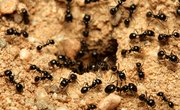
Ants belong to the family known as Formicidae, a group of insects with characteristic elbow-shaped antennae. The world is host to more than 12,000 species of ant, with over 450 of those found in North America. Like closely related bees and wasps, these social insects live in colonies. Variation in the body forms depends on their job, or caste, within their colony. An ant with wings is either a queen or a male. Both queens and males use their wings for flying in search of mates.
Ant Colony
After mating, winged female ants, which are typically larger than the males, shed their four membranous wings. They then either establish a new colony or enter an existing colony as a queen. Queen ants are responsible for laying all of the eggs for the colony.
Winged male ants are produced only at certain times of the season from unfertilized eggs, and their sole purpose is to mate. With most species, the males are much smaller than the queens but still possess four wings. Male ants die shortly after mating, usually within a couple of weeks.
Worker ants are the wingless caste of the colony. They are responsible for tending to the immature larvae, foraging for food and maintaining the nest. Within some species, such as leaf-cutter ants and army ants, there are workers responsible for defending the colony. These have modified body forms, like enlarged heads, suitable for their specific task. Although workers are all female, hatched from fertilized eggs, they do not become reproducing queens.
Ant Swarm
Flying ants in the house during summer are an indication that male ants and female potential queen ants are dispersing from their colonies and looking for mates. If you are suddenly plagued by flying ants inside or outside of your house, you are witnessing this mating swarm.
If winged ants are swarming inside your house, there is likely an established colony either in it or nearby. Some species are potentially dangerous to the structure of your home. Carpenter ants help in the decomposition of wood by tunnelling through decaying wood to expand their colonies. But inside your home, this same tunnelling behavior weakens wooden structures.
Fire ants may also swarm within your house during their mating period. This is usually an indication that there is a nest outside, near your home. An infestation of fire ants requires treatment before they become a severe nuisance.
Flying Ant Imposters
Winged ant-like creatures often form mating swarms similar to ants. Termites belong to the order of insects called Isoptera and, although they have similar behaviors and habitats, their body form is significantly different to that of an ant.
Termites lack the defined waist typical of ants. They also have straight antennae as opposed to an ant's elbowed antennae. Winged termite castes have four wings that are approximately the same size and shape. Winged ants have two large front wings with two smaller hind wings.
Flying Ant Behavior
Environmental signals such as weather conditions or the changing length of days trigger winged, reproducing ants to leave their colonies. Those same conditions work as cues for all of the nearby ant colonies, resulting in the reproductive ant swarms. With all winged ants leaving home at once, there is more opportunity for finding non-related mates.
Termites also follow these same environmental cues before dispersing, often resulting in areas with large swarms of mating insects over several days. The winged castes of some ant species, particularly carpenter ants, along with winged termites are nocturnal. These swarming insects are frequently attracted to, and can be found circling, lights at night.
References
- University of Missouri Extension: Urban Entomology: Ants
- Texas A&M AgriLife Extension: Insects in the City: Identifying Household Ants
- University of California Statewide Integrated Pest Management Program: How to Manage Pests: Ants
- Arizona State University: Ask a Biologist: Face to Face With Ants
- Texas A&M AgriLife Extension: Insects in the City: Swarming Insects Indoors
Resources
About the Author
Ms. Jean Godawa is a former science educator and freelance writer with a degree in biology and environmental science. She is fascinated by insects, and conducted field research in the rainforests of South America and South East Asia. She contributes science and nature articles to online and print publications including ONNature, Trellis and The Globe and Mail.
Photo Credits
ants fighting image by Anton Chernenko from Fotolia.com
